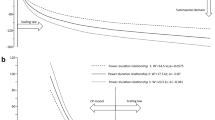Abstract.
The present study sought to create a scaling-derived cycle ergometer protocol (SDP) that was derived theoretically and would correlate highly with actual uphill time-trial (TT) cycling performance. Local competitive cyclists each completed the SDP (an incremental test to exhaustion) using their own bicycle mounted on a stationary trainer, together with either a short (6.2 km, 2.9% grade; n=8 men and 5 women) or long-course (12.5 km, 2.7% grade; n=8 men) uphill TT. Maximal power output \( \left( {\dot W_{{\rm max}} } \right) \) and power at the ventilatory threshold \( \left( {\dot W_{{\rm VT}} } \right) \) were determined from the SDP results, as well as maximal oxygen uptake \( \left( {\dot V{\rm O}_{{\rm 2max}} } \right) \) , using standard indirect calorimetry procedures. Actual TT speed correlated very highly with both SDP completion time (r=0.97–0.98) and relative \( \dot W_{{\rm max}} \) (watts per kilogram; r=0.92–0.97) for both uphill TT races. Correlations between TT speed and more demanding measurements \( \left( {\dot V{\rm O}_{{\rm 2max}} {\rm ,}\dot W_{{\rm VT}} } \right) $$ % MathType!MTEF!2!1!+- % feaaeaart1ev0aaatCvAUfKttLearuavP1wzZbItLDhis9wBH5garm % Wu51MyVXgaruWqVvNCPvMCaebbnrfifHhDYfgasaacH8srps0lbbf9 % q8WrFfeuY-Hhbbf9v8qqaqFr0xc9pk0xbba9q8WqFfea0-yr0RYxir % -Jbba9q8aq0-yq-He9q8qqQ8frFve9Fve9Ff0dmeaabaqaciGacaGa % aeqabaWaaeaaeaaakeaadaqadaqaaiqbbAfawzaacaGaee4ta80aaS % baaSqaaiabbkdaYiabb2eanjabbgeabjabbIfaybqabaGccqqGSaal % cuqGxbWvgaGaamaaBaaaleaacqqGwbGvcqqGubavaeqaaaGccaGLOa % Gaayzkaaaaaa!3C85! $$ \left( {{\rm \dot VO}_{{\rm 2MAX}} {\rm ,\dot W}_{{\rm VT}} } \right) \) were generally lower and more variable (r=0.54–0.97). These results would indicate that two non-laboratory dependent measurements (SDP completion time and relative \( \dot W_{{\rm max}} \) ) derived from the SDP are valid markers for predicting actual uphill TT performance. This protocol may be useful to cycling coaches and athletes in identifying talented cyclists or for tracking changes in cycling performance outside of the sports science laboratory environment.
Similar content being viewed by others
Author information
Authors and Affiliations
Additional information
Electronic Publication
Rights and permissions
About this article
Cite this article
Heil, .D., Murphy, .O., Mattingly, .A. et al. Prediction of uphill time-trial bicycling performance in humans with a scaling-derived protocol. Eur J Appl Physiol 85, 374–382 (2001). https://doi.org/10.1007/s004210100442
Accepted:
Issue Date:
DOI: https://doi.org/10.1007/s004210100442




